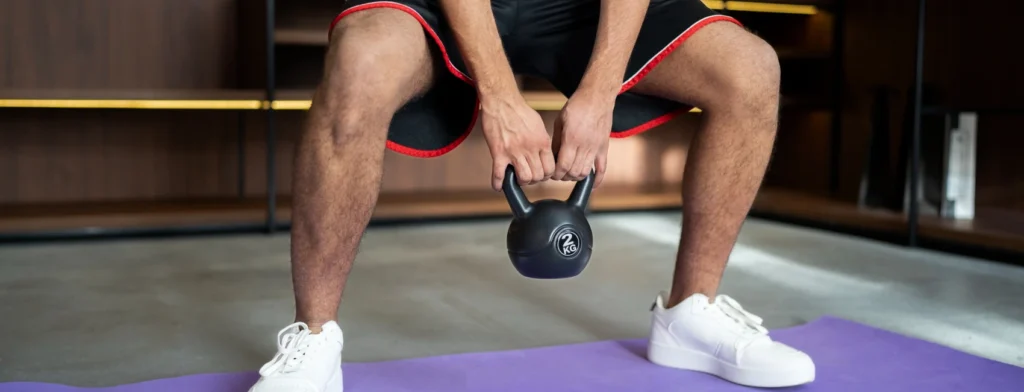The hinge swing exercise is a dynamic movement that primarily targets the muscles of the posterior chain, including the glutes, hamstrings, and lower back. It involves hinging at the hips and swinging a weight, such as a kettlebell or dumbbell, between your legs and up to chest height. This exercise is often used as a variation of the traditional kettlebell swing and can be beneficial for individuals who are new to exercise or looking to strengthen their lower body.
When performing the hinge swing, the main muscle group worked is the glutes, or the buttocks muscles. These powerful muscles play a crucial role in various movements, such as hip extension and stabilization. By engaging the glutes during the hinge swing exercise, you can strengthen and tone these muscles, which can improve your overall lower body strength, power, and athletic performance.
In addition to the glutes, the hinge swing also targets the hamstrings, which are located at the back of the thighs. The hamstrings are responsible for knee flexion and hip extension. By performing the hinge swing, you can engage and strengthen your hamstrings, which can contribute to improved lower body strength, balance, and flexibility.
Another muscle group activated during the hinge swing exercise is the erector spinae, which is a group of muscles that run along the spine. These muscles help support and stabilize the spine, particularly during movements that involve hip hinge patterns. By incorporating the hinge swing into your routine, you can engage and strengthen the erector spinae muscles, which can support proper posture, spinal alignment, and reduce the risk of lower back pain.
Furthermore, the hinge swing also engages the core muscles, including the rectus abdominis, obliques, and deep core stabilizers. These muscles play a vital role in maintaining stability and proper alignment during the movement. By performing the hinge swing, you can improve core strength, stability, and overall functional fitness.
Hinge Swing – Instructions & Steps
- Start by straddling a dumbbell or kettlebell with your feet hip width apart or more
- Graps the weight and stand straight
- Lower the weight between your legs and swing it upwards, but do not go beyond the height of your face
- Swing the weight back down and repeat
Benefits of Hinge Swing
The hinge swing exercise offers a range of non-athlete benefits that can enhance your overall fitness and well-being. By incorporating this exercise into your routine, you can experience improvements in lower body strength, power, and stability. Let’s explore some of the key benefits you can expect from including the hinge swing in your fitness regimen.
Improved Glute Strength
The hinge swing primarily targets the glute muscles, helping to strengthen and tone your buttocks. Strong glutes not only improve lower body strength and power but also contribute to better posture and stability.
Stronger Hamstrings
Performing hinge swings engages and works the hamstrings, which are important for knee flexion and hip extension. Strengthening the hamstrings can improve lower body stability and help prevent injuries.
Enhanced Core Stability
The hinge swing exercise requires core engagement to maintain stability throughout the movement. Regular practice can strengthen your core muscles, improve stability, and support proper posture.
Improved Lower Back Strength
The hinge swing activates the erector spinae muscles, which run along the spine and help support the lower back. Strengthening these muscles can alleviate lower back pain, improve posture, and reduce the risk of injury.
Increased Hip Mobility
Performing the hinge swing involves a hip-hinging motion, which helps improve hip mobility and flexibility. This can be particularly beneficial for individuals who spend long periods sitting or have sedentary lifestyles.
More About Hinge Swing
The hinge swing is considered a compound exercise. It is a dynamic movement that engages multiple muscle groups, primarily in the posterior chain, and is commonly used in kettlebell training and other functional training programs. The hinge swing involves a hip-hinging motion to generate momentum and swing a kettlebell or similar weight in front of the body.
During the hinge swing, the following muscle groups are primarily engaged:
- Hamstrings: The muscles on the back of the thighs are heavily engaged during the hip-hinging motion to control the descent and power the swing.
- Glutes: The gluteus maximus, the largest muscle in the buttocks, is a primary mover in the hinge swing to extend the hips and generate power.
- Lower back (Erector Spinae): These muscles work isometrically to stabilize the spine during the hip-hinging motion.
- Core muscles: The rectus abdominis, transverse abdominis, and obliques are engaged to stabilize the torso and maintain proper posture during the swing.
- Shoulders and upper back: The deltoids and muscles of the upper back help control the movement of the kettlebell and stabilize the shoulders.
- Forearms and grip: The muscles in the forearms and hands are engaged to hold onto the kettlebell and control its movement.
The hinge swing is an effective compound exercise for developing explosive hip power, improving posterior chain strength, and enhancing overall athleticism. It is a full-body movement that involves coordination and stability and can be used for conditioning and power development.
When performing the hinge swing, it’s essential to maintain proper form and use a weight that allows for controlled movement throughout the exercise. Learning the proper technique from a qualified instructor is recommended, especially for beginners, to ensure safety and maximize the benefits of this dynamic exercise.



